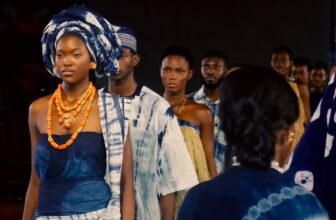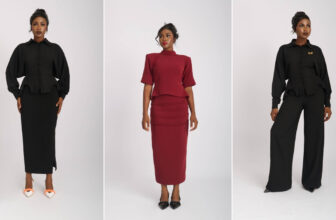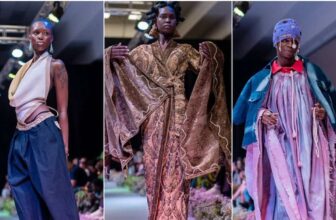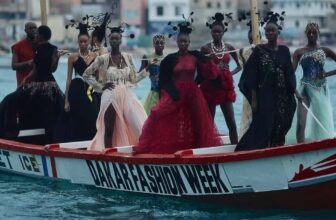9 Things You Didn’t Know About Gomesi, Uganda’s Traditional Dress
Gomesi is the most commonly worn dress for women in Uganda; it is a staple in many of Uganda’s cultural ceremonies and rituals. It is worn during weddings, introductions (kwanjula), and other important life events.
No traditional function in central Uganda and many other parts of the country is complete without women immaculately dressed in the Gomesi—a stunning, floor-length, brightly colored dress with a square neckline and short puffed sleeves. The dress is usually fastened with a sash or large belt below the waist, above the hips, and features a pair of buttons on the left side of the neckline.
The history of the Gomesi goes back to 1905 when two Goan tailors were asked to create a uniform for girls at a missionary-run boarding school. Over time, the dress became widely adopted and is now a signature piece for Ugandan women.
In Uganda, no traditional event is complete without women wearing the Gomesi. From weddings to cultural ceremonies, this dress is a symbol of pride and tradition.
Ahead are 9 things you didn’t know about the Gomesi, Uganda’s traditional dress.
Gomesi has had Four Stages of Evolution
According to Wikipedia, the Gomesi can be traced back to a traditional style of clothing in Uganda called Lubugo, which originated around 600 AD. However, the most reliable scholarship places the origins of the Gomesi in 1905. It was introduced by Caetano Gomes, a Goan designer living in Uganda, then a British Protectorate.
The dress gained popularity when the wife of Daudi Cwa II, the Kabaka (king) of Buganda, wore it at her husband’s official coronation. Since then, the Gomesi has evolved through four main stages, with changes in materials and decorative styles:
 Photo Credit: Instagram.com/@delight_decor_256
Photo Credit: Instagram.com/@delight_decor_256 First, the original Gomesi was made from bark cloth, a traditional Ugandan fabric. In the 1960s, the Gomesi transitioned to using cotton, making it more accessible and comfortable. By the 1970s, the dress was made from khadi, a hand-spun and hand-woven cloth. The most recent evolution features the kikooyi, a brightly colored fabric that adds vibrancy to the traditional design.
Gomesi’s Design Elements are Quite Symbolic
The square neckline, puffed sleeves, and sash on the Gomesi dress are not just aesthetic choices but are steeped in cultural significance.
For instance, the square neckline embodies stability and balance, with its straight lines symbolizing order and harmony—a reflection of Uganda’s reverence for these virtues. The puffed sleeves are not just about fashion; they are symbols of femininity and grace, creating a gentle silhouette that celebrates elegance and beauty. In a cultural context, these sleeves can also signify fertility and the pivotal roles of women in family and community life.
Similarly, the waist sash is more than a decorative element; it is a symbol of unity and cohesion within communities. Tying the sash is a gesture that signifies bonds and connections, representing the continuity of traditions and values across generations.
Generational Craftsmanship is the Essence of Gomesi Design
Making a Gomesi requires a deep level of skill and heritage-based expertise. The techniques involved have been honed over generations, involving intricate processes like hand-sewing, embroidery, and meticulous detailing.
Artisans specializing in Gomesi creation bring with them a wealth of knowledge acquired through years of practice. They are well-versed in fabric selection, pattern creation, and stitching methods unique to Gomesi’s design.
Gomesi is a Dress of ‘Respect’
Wearing a Gomesi in social settings shows respect for the occasion and the people involved. For example, at weddings, it indicates the importance of the event and the person wearing it, like the bride or close family.
 Photo Credit: Uganda.com
Photo Credit: Uganda.com During cultural gatherings, it acknowledges the significance of the gathering and the people leading it, showing respect for traditions and community values. The Gomesi helps create a respectful and dignified atmosphere in these social situations.
Kikooyi/Kanga is Usually Worn Beneath the Gomesi
The Kikooyi/Kanga is a rectangular piece of fabric, often brightly colored and patterned. Traditionally, it serves as a wrap or skirt, ensuring coverage and modesty beneath the Gomesi.
Its main purpose is to prevent the Gomesi fabric from clinging to the body. Beyond its role as an undergarment, the Kikooyi/Kanga is incredibly versatile. It doubles as a headscarf, a baby sling, a picnic mat, or even a makeshift bag for carrying various items.
Tying the Kikooyi Requires Special Skill
Tying a kikooyi under a Gomesi requires a special skill that encompasses several key considerations. It begins with choosing the right length of the kikooyi to ensure proper coverage and comfort.
The folding technique plays a part in creating a neat and even shape, whether opting for a rectangular, square, or triangular fold. Adjusting the kikooyi for fit is essential, ensuring it sits securely over the shoulders without restricting movement.
Various tying methods, such as knots, pins, or draping, can be employed to achieve the desired look, balancing color coordination and pattern alignment with the Gomesi for a cohesive ensemble.
Dressing up in Gomesi is Time-Consuming
Due to its layered clothing structure, complex design elements like the square neckline and sash tying, and the careful handling required for delicate fabrics like silk or satin, dressing up in Gomesi can be strenuous.
The process involves putting on multiple layers, wrapping the sash meticulously, fastening buttons, and adding accessories like jewelry and headscarves.
 Photo Credit: Instagram.com/@esckoimages_ltd
Photo Credit: Instagram.com/@esckoimages_ltd Each step demands attention to detail to achieve the traditional silhouette and honor the cultural significance associated with wearing a Gomesi, making it a deliberate and meticulous process that many women embrace to connect with their heritage.
Gomesi is Best Made with Polyester Material
Polyester is a favored material for crafting Gomesi dresses due to its durability, easy care properties, affordability, color retention, versatility in blending with other fibers for enhanced aesthetics like sheen, and its ability to offer modern designs while remaining budget-friendly.
Polyester is also known for its ability to mimic the look and feel of more expensive fabrics. This allows Ugandan fashion designers to create Gomesis with modern aesthetics while keeping them affordable and easy to maintain.
Gomesi is Here to Stay
Like Ghana’s Kente, Nigeria’s Agbada, and Senegal’s Yéré olof, Uganda’s Gomesi has become a lasting symbol of the country’s culture in African Fashion.
Even as fashion changes, modern touches keep the Gomesi relevant for both older and younger generations. So, it’s not just a trend; it’s a part of Uganda’s identity that’s here to stay, embodying the beauty and pride of Ugandan women.
Photo: instagram.com/karizmaphotographyug






